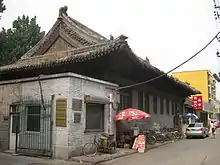Hongjiao
Aisin Gioro Honjiao (寧良郡王 弘晈; 17 June 1713 – 9 September 1764) was Qing dynasty imperial prince as the fourth son of Yinxiang, Prince Yixian of the First Rank and Kangxi Emperor's grandson. In 1730, he was granted a title of Prince Ning of the Second Rank. As the title was not granted iron-cap status, each successive bearer would hold diminished ranks vis-a-vis his predecessor.
Life
Hongjiao was born on 17 June 1713 to lady Joogiya, primary princess consort Yixian of the First Rank.[1] In 1730, Hongjiao was granted a title of Prince Ning of the Second Rank.[2] He had 2 biological sisters, including Princess Hehui of the Second Rank who was adopted into the palace since young,[3] and 2 surviving biological brothers, including Hongxiao, Prince Yixi of the First Rank.[4] In 1739, Hongjiao formed a fraction together with Prince Li Hongxi, Hongsheng (son of Prince Heng Yunqi), Hongchang and Yunlu (prince Zhuang of the First Rank) aimed to oust Qianlong Emperor from power and set Hongxi as an emperor.[5] The fraction failed to achieve its aim as Hongpu dispatched a messenger to report an urgent secret matter to the Emperor who stayed in Rehe at that time.[6] Hongpu was arrested and demoted to grace defender duke after the imperial hunt.[7] Hongxi and Hongsheng were stripped of their titles and imprisoned while Hongjiao was only stripped of his title.[8] However, Imperial genealogy as well as "Genealogy of the Aisin Gioro clan" don't mention Hongjiao's deposition. Possibly Hongjiao was quickly restored as the second ranking prince. Another sources state that he was only deprived of his allowance.[9]
In 1749, Hongjiao was ordered to make sacrifices in the Jing'anzhuang (静安庄).[10] In 1750 and in 1760,[11] Hongjiao was sent to make sacrifices at the Temple of Heaven.[12] In 1752, Hongjiao was stripped of his position in the Ministry of Revenue due to several delicts.[13]
Hongjiao was a renowned poet. His works included "Stories of Chrysantemums" and "Series of the Prosperous Dynasty" in 13 volumes.
Hongjiao died on 9 September 1764 and was posthumously honoured as Prince Ningliang of the Second Rank (宁良郡王, meaning "tranquil and gentle"). He was succeeded by the second son, Yongfu.[14]
Former residence

Hongjiao's former residence was called "Little Prince Yi Manor" as one of his descendants, Zaidun, was transferred into Prince Yi of the First Rank peerage. The mansion was built in 1730 in Dongcheng District of Beijing. The residence is not preserved in the Siheyuan style due to modern-day reconstructions. After the Xinhai revolution, the opera stage, stables and outer courtyard were converted into storehouses.[15] During the Qianlong era, the prince Ning manor was described as one of the most luxurious and beautiful princely manors in Beijing.[16]
Family
Hongjiao was married to lady Sirin Gioro, daughter of secretary Zhuolintai (卓林泰). Later, he married lady Ula Nara, daughter of Grand Secretary of the Wenhua hall Chalang'a. As Ula Nara clan was made extinct in 1703, official Qing dynasty records write the name of the clan as "Nara".
References
- "Genealogy of the Aisin Gioro clan".
- Tian, Shuhe (2018). 北京市區主要街道景觀導覽. 崧博出版事業有限公司.
- 《總管內務府奏為四公主下嫁多爾吉色布騰核定陪嫁女子人口莊頭數目事折》/"A memorial on collecting the dowry for Fourth Princess".
- Zhao, Erxun. 《清史稿》 表四 皇子世表四/ Draft History of Qing.Table 4. Imperial Princes. Genealogy tree 4.
- Jin, Hengyuan (2018). "Another Yongzheng". Beijing Book Co. Inc.
- Gao, Yang (2001), Yang (2001). . 三春爭及初春景/Fight in the spring scenery. 生活・讀書・新知三联书店. p. 686.
- Feng, Jingzhi (2003). The art of weaving in the Qing. Chunfeng Cultural Press. p. 1065.
- Hua, Bin (2018). "The Qianlong Emperor". 千華駐科技出版有限公司.
- "Qianlong Reign|The Palace Museum". en.dpm.org.cn. Retrieved 2021-01-23.
- "A decree assigning Prince Ning of the Second Rank Hongjiao and others to carry out rites at the Jing'anzhuang". 1749.
- "A decree assigning Hongjiao and others prayer in the Temple of Harvest". 1760.
- "A decree assigning Hongjiao and others making sacrifices at the Temple of Prayer of Harvests". 1750.
- "A decree dismissing Prince Ning of the Second Rank Hongjiao from his duties in the Ministry of Revenue".
- 爱新觉罗家族全书. Jilin Public Press. 1997. p. 122.
- Qu, Xiaoyue (2008). "老北京皇都风貌——老北京王府与大宅园"/"Beautiful imperial city of Beijing. Old Princely Manors and Gardens of Beijing". Beijing Book Co. Inc.
- 《乾隆京城全图》.
- "详细资料介绍_爱新觉罗宗谱网". www.axjlzp.com. Retrieved 2021-01-12.
